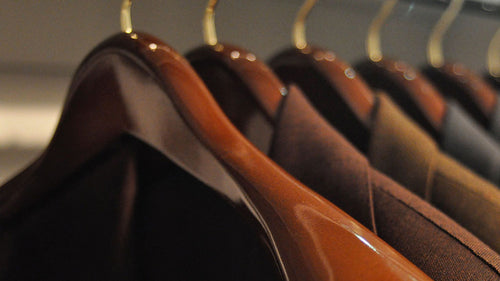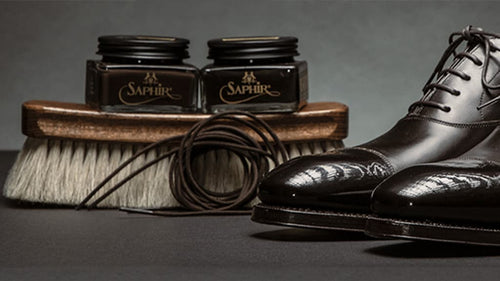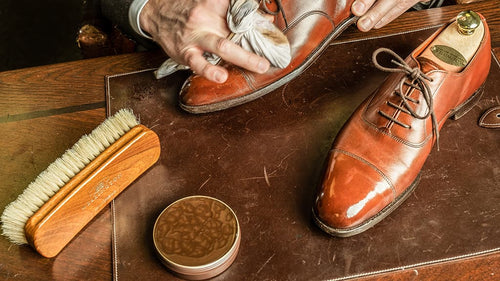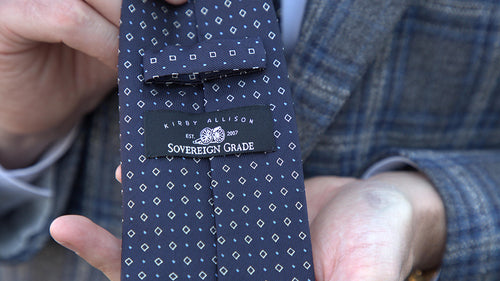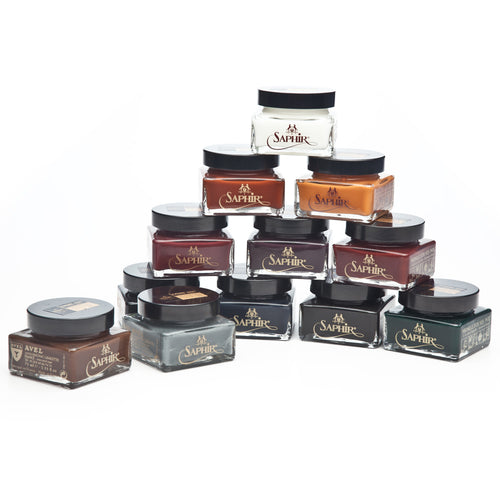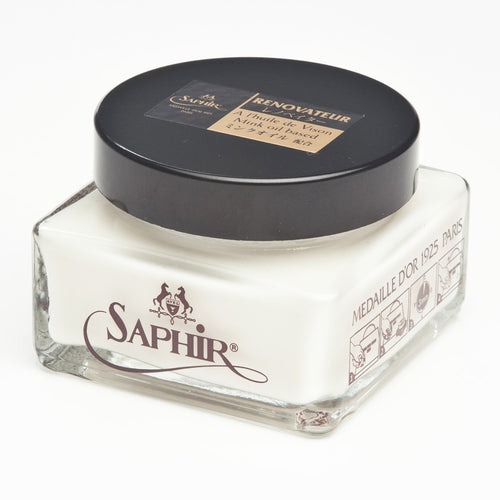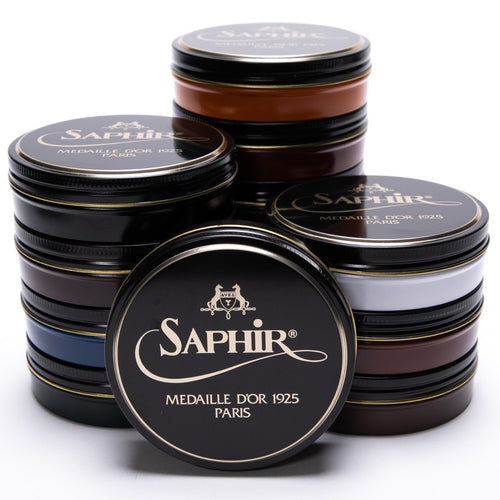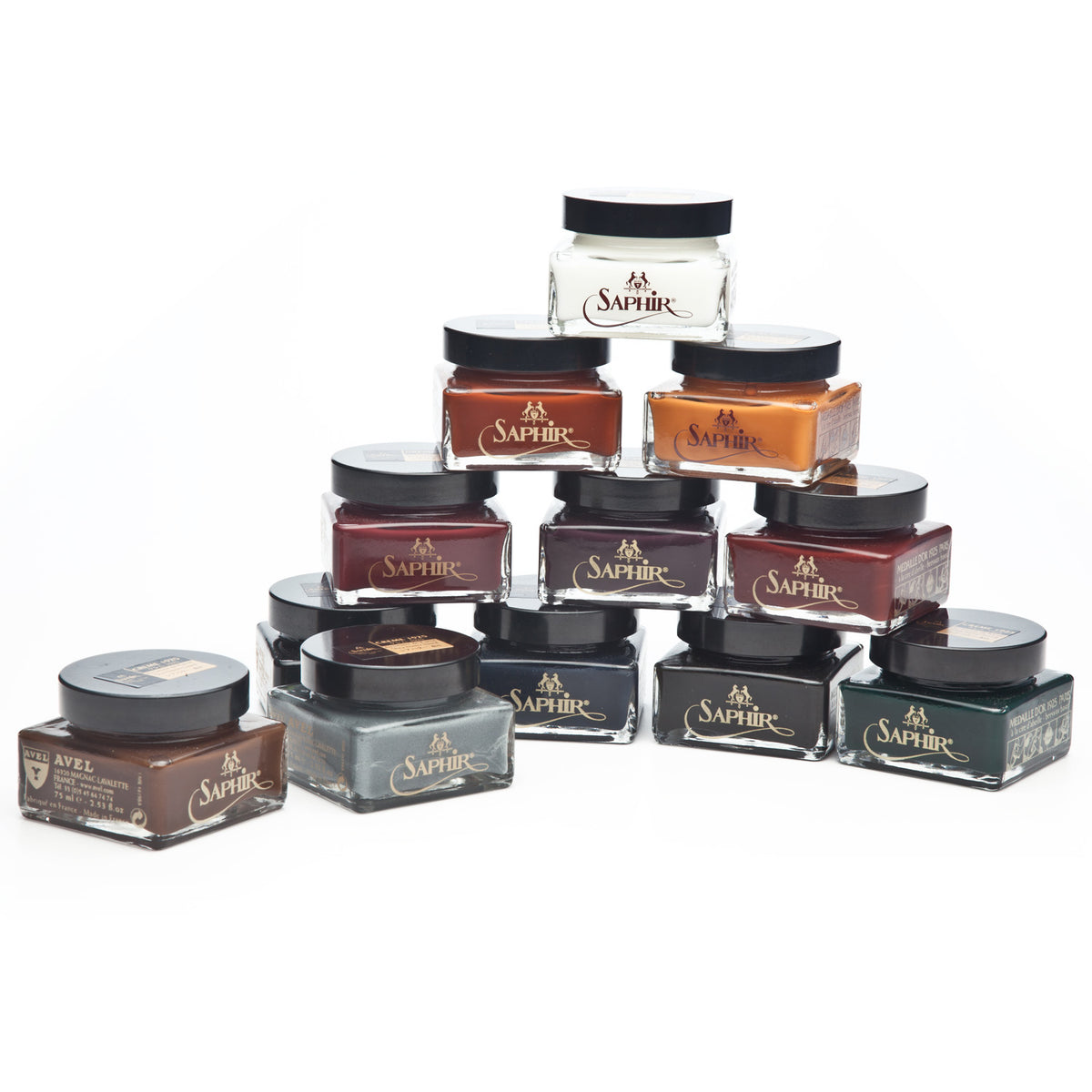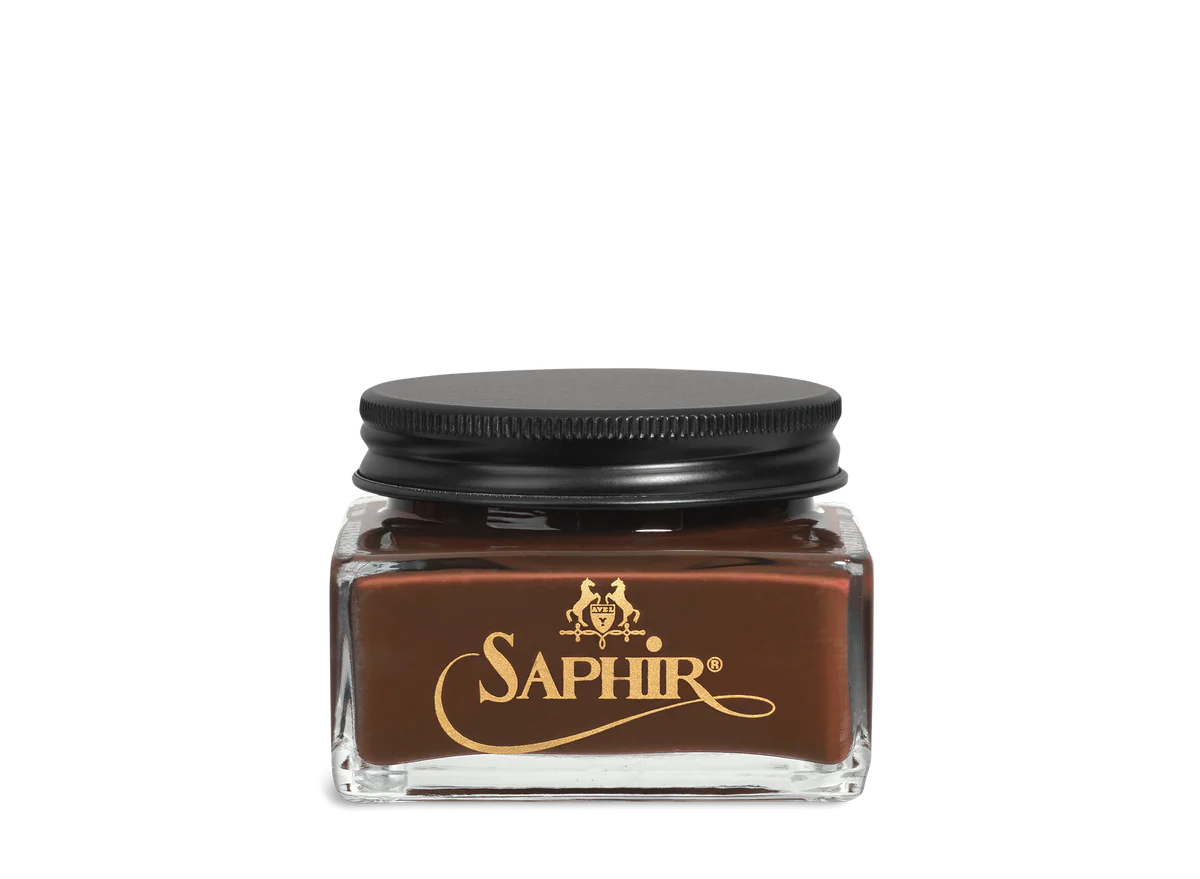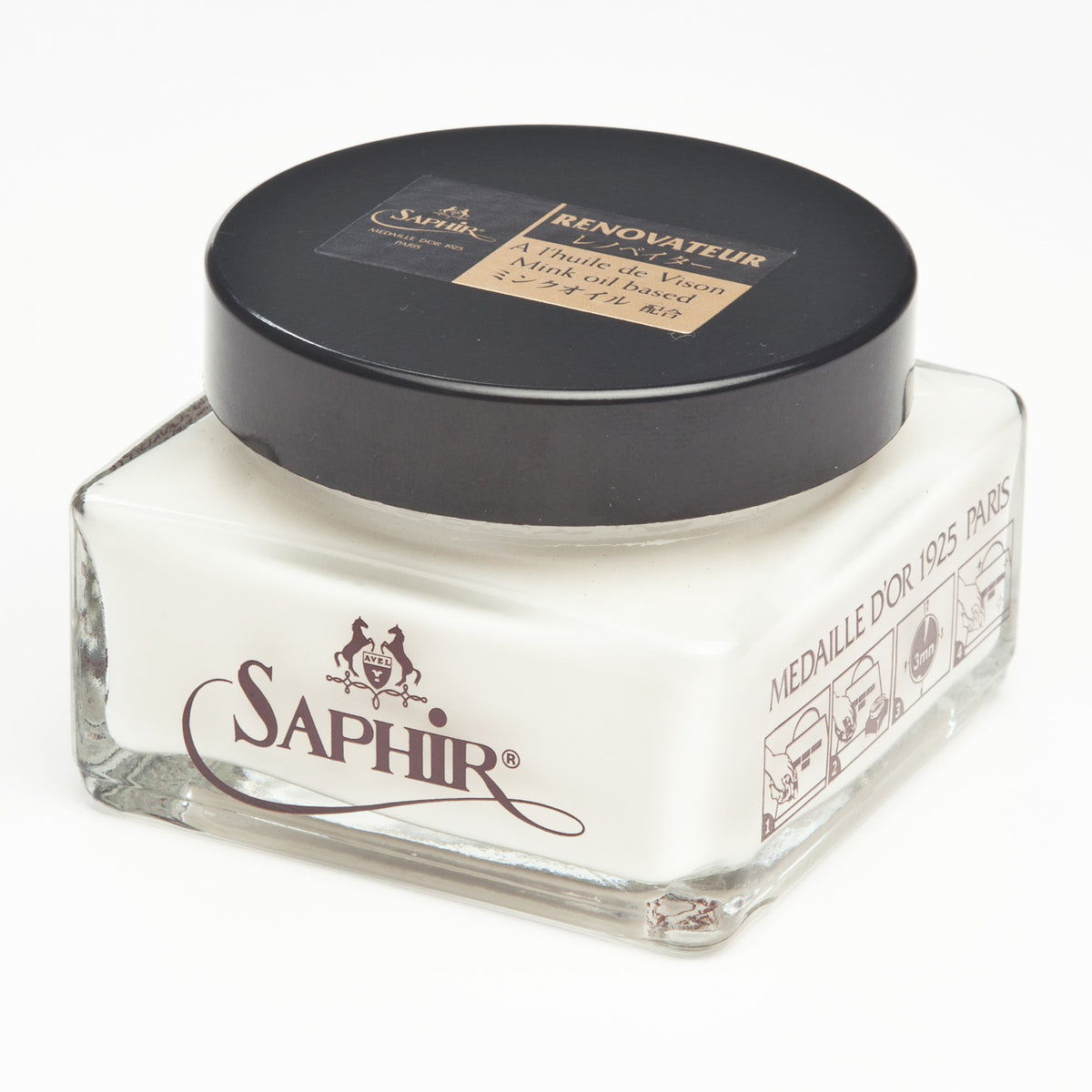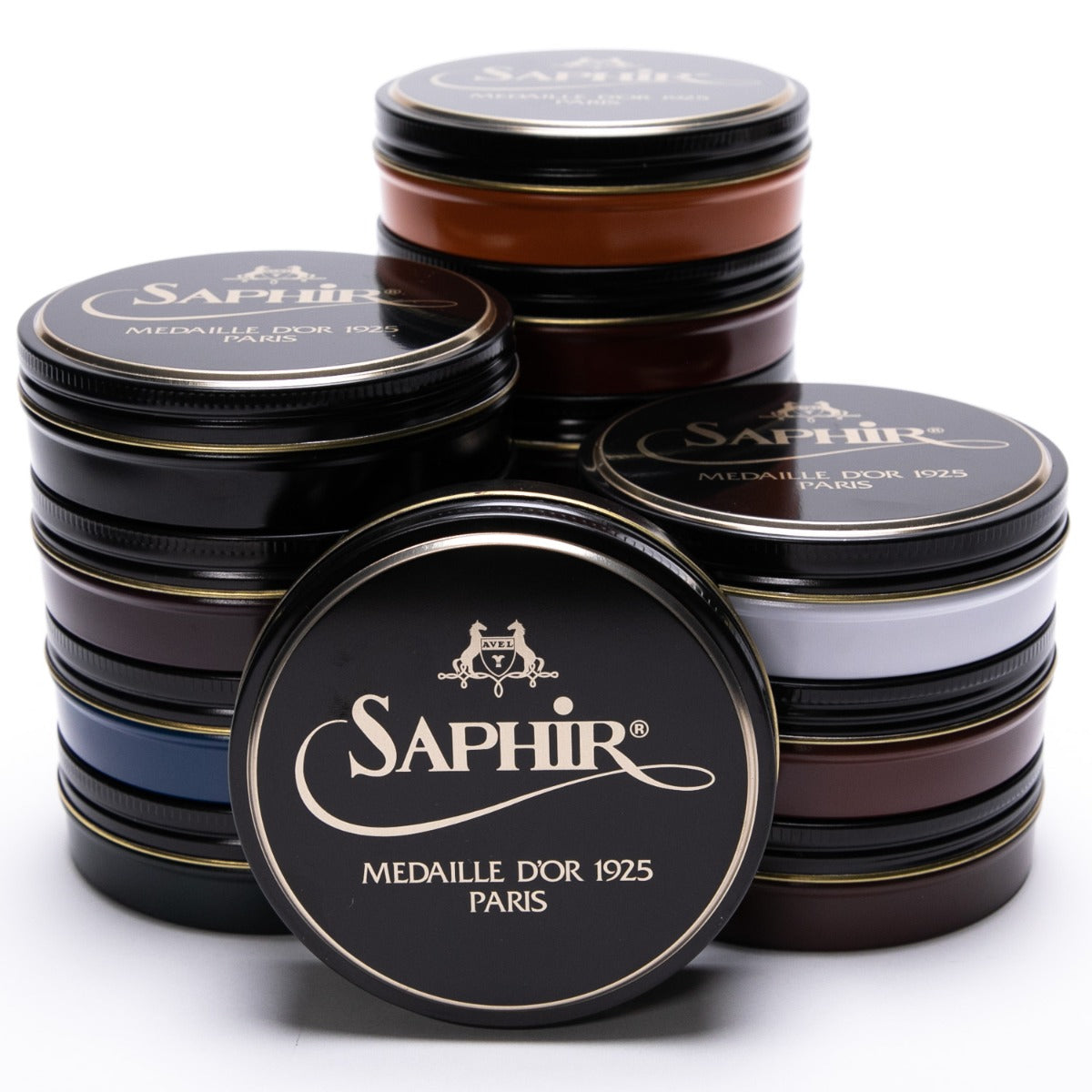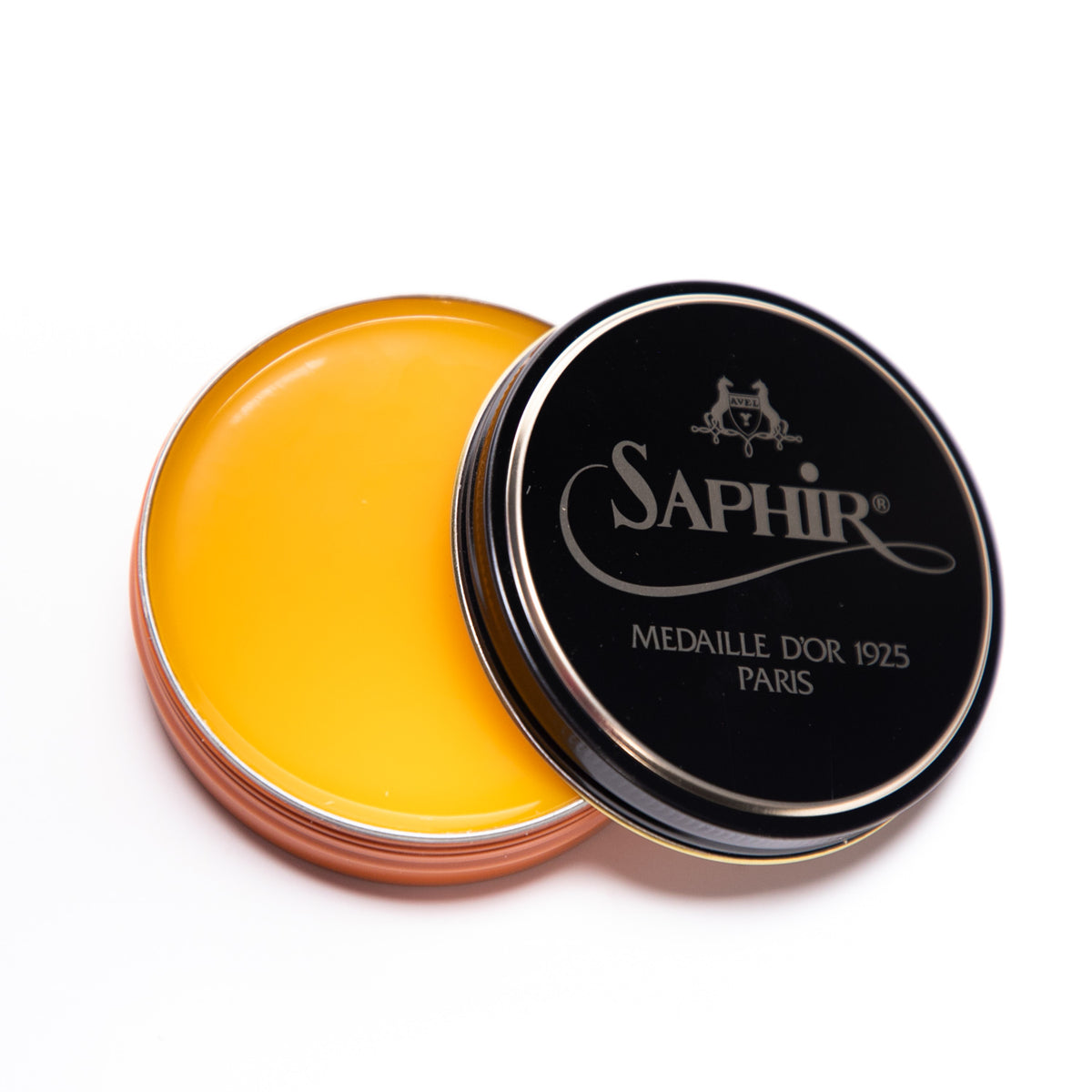Learn how to condition and polish cordovan leather shoes using our Saphir shoe care products.
Products used in this video:
Transcription
Hi, my name is Kirby Allison, and I'm the founder of The Hanger Project. Today I'm going to show you how to take care of shell cordovan leather dress shoes. Shell cordovan is completely different than standard calfskin and as such it really requires special care in order to protect and extend the life of these shoes. If taken care of properly, shell cordovan can literally last a lifetime. Cordovan couldn't be any more different than calfskin. First, cordovan is from a horse not a cow. Second, instead of the skin cordovan is actually a membrane. It's the rear membrane or the flat membrane that you find under the rear quarters or hind quarters of the horse. Now what makes cordovan leather really special is that it has a very tight, fibrous structure that helps make this material so durable. And one of the things that's special about cordovan during the tanning process is that actually, when Horween tans it, it's rolled under glass bottles to further compress that core structure or that membrane structure. So why this is important whenever it comes to caring for your cordovan shoes, is that you really want to stay away from using traditional calfskin products that use solvents to penetrate that leather. If you use those traditional calfskin products with solvents, then what it can do is it penetrates the cordovan and can cause those fibers to expand and actually compromise the kind of innate integrity of the cordovan leather.
This tutorial is going to walk you through the complete process for both cleaning, conditioning, and shining your cordovan shoes using Saphir shoe polish. In this tutorial, we're going to be utilizing the Saphir Medaille d'Or collection of luxury shoe care products. Now, what I really love about Saphir Medaille d'Or is it's the only collection of shoe polish to have a cordovan-specific polish developed specifically for this unique leather. Now the cordovan polish utilizes a Neatsfoot oil in order to condition and nourish the cordovan leather and to maintain that oil structure without introducing solvents like a traditional calfskin cream polish does. We're also going to be using the Saphir Renovateur, which is a gentle cleaner and conditioner; it's a water based formulation that uses mink oil. Again, to help clean and then condition, and then another product that we're going to be using that is completely unique to cordovan care is the deer polishing bone. Now the deer polishing bone is used to smooth out the creasing that occurs naturally with cordovan across the vamp and to help redistribute some of those waxes that expel to the surface. And then finally if you desire a higher gloss polish than what the cordovan cream is able to achieve, I really enjoy using Saphir's new Medaille d'Or Mirror Gloss. I specifically recommended it for the exotics such as cordovan or crocodile and cordovan because it has a lower concentration of solvents than their traditional Pate de Luxe wax polish, and so you're still building up that layer or that shine using hard waxes, but without introducing those solvents into the leather.
For today's shoeshine video we're going to be using a pair of Anthony Cleverley Cordovan Churchill shoes. Now the Churchill from Anthony Cleverley or George Cleverley is one of their most iconic shoes that was developed specifically for Churchill because whenever he was getting older he was having trouble bending over to tie his shoes. So, they did basically a lace up wingtip with a lazy man's side. These are a limited edition pair, one of 50 cordovan Churchills, that George Glasgow lent to me for this tutorial. The first step depending on how dirty or soiled your cordovan leather shoes are is going to be to clean them. Now if they're lightly soiled like these are I recommend just using a little bit of water and a horsehair shoe shine brush in order to just brush off any type of dirt or soiling that may be on the surface. Now if your cordovan shoes are more soiled than this, you can use the Saphir leather cleaning soap to actually shampoo the leather but that's not necessary for these because they're really in pretty good condition.
Next we're going to apply a light coat of the Saphir Medaille d'Or Renovateur to the cordovan shoes. Now I like starting with the Saphir Renovateur because the water based mink oil formulation helps provide additional cleaning while also nourishing the cordovan with the mink oil. Take a little bit of the Saphir Renovatuer and then apply it using moderate pressure and small circular motions. And again, what we're doing here is one, providing additional cleaning to pull off any kind of small superficial water spots. And then also, that mink oil is going to penetrate into the cordovan to begin that nourishing process. I'm going to allow this a few minutes to dry and then I'm going to come back over it and buff it off with the horsehair shoe shine brush.
After you've allowed the Renovateur a few minutes to dry then come on top of it with the horsehair brush to buff it off. Now I'm using one of our Hanger Project Deluxe Shoeshine Brushes. Now, this brush uses a high-density 100 percent tail hair. And what I like about this is because it has a 100 percent tail and no mane, you don't get any of the shedding that you do with normal brushes. Now one of the things that's quite unique to cordovan is that because it's such an oily leather you really do want to spend extra time brushing it versus what you would do on a standard pair of calfskin shoes.
Next what we're going to do is we're going to take our deer polishing bone and we're going to use it to smooth out some of the creasing that occurs across the vamp. Now a deer polishing bone is a deer bone that is oiled. So, the natural oils are retained by the bone. And what that does is it helps lubricate the bone so that it slides across the leather without scratching it. Now during this step, you really need to be careful not to use any of the hard edges. Although cordovan is a very tough leather, if you try hard enough you will scratch it. So, we don't recommend trying too hard. I'm going to take the deer polishing bone. You definitely want to keep the shoe tree in the shoe during this process. And I'm just going to kind of press those creases out. I'm using moderate to firm pressure on one of the smooth edges of the deer bone in small kind of circular motions to help work those creases out.
Now this white residue you see right here is basically us redistributing those waxes and some oil from the bone being imparted onto the leather. So, once we buff this off and then come on top with the cordovan polish that will completely disappear. So you can see that I've made really good progress and the left shoe. I've done a good job right through here. But still right here where the wingtip is kind of sewn and the pattern is sewn into this cordovan I could probably use a little more work.
It's really important that the deer polishing bone still has the natural oils and that's what helps lubricate, slide the bone, and then kind of redistribute those oils in the cordovan. I highly recommend storing your deer polishing bone in a plastic Ziploc bag to minimize the amount of contact it has with the air during storage. And then if you ever find that your deer bone has kind of lost that smooth kind of oily texture then that means it's time to replace the deer bone.
Next we're going to condition and polish the cordovan leather using the Saphir Medaille d'Or Cordovan Cream Polish. Now the Cordovan Cream Polish is highly unique. It was formulated specifically for cordovan shoes and to the best of my knowledge, it's the only cream product out there, or shoe care product for that matter, that is formulated specifically for the unique characteristics of cordovan leather. Now what's unique about the cordovan polish versus the traditional Pommadier cream polish is for one, it doesn't have a high solvent base. So, it's not going to penetrate into that leather and help expand that very tight kind of membrane structure. And then it uses a Neatsfoot oil base in order to penetrate and condition the cordovan, which at its essence is really an oiled leather. Now it's available in five different colors, in a neutral, a cordovan, a light brown, a dark brown, and a black. Now I recommend matching it as closely as possible, but if you can't find a perfect match then you can always use the neutral.
Now one of the other things that's nice about the cordovan cream polish is that it has pigment. As you remember pigment is very important towards the polishing process because it helps repair any types of nicks or scratches or discoloration that occurs just during natural wear. I really recommend always using a pigmented cream polish whenever you're polishing shoes to help restore and renew that finish.
You're going to apply the cordovan cream polish the same way as you would apply any cream polish, and that's with a cotton chamois. I'm just going to wrap this cotton chamois tightly around my two fingers and then take a little bit of the cordovan polish on my cotton chamois. I like to even it out a little bit on the top of the lid and then just apply it using circular motions and massaging it into the cordovan leather. Since cordovan is such a dense leather I'm going to recommend that you actually allow the cordovan at least 30 minutes to fully absorb and nourish the cordovan leather and for the waxes to dry. I'm going to let these shoes sit here for about half an hour and then we're going to come back and buff that cordovan polish off.
Now that we have allowed the Saphir Cordovan cream polish to dry and fully absorb into the leather I'm just going to buff it off using our Hanger Project Horsehair Shoeshine Brush. Cordovan really does require a lot of additional brushing. So brush to your heart's desire. The more brushing the better, especially whenever it comes to cordovan.
So you can see with just one coat of the Saphir Medaille d'Or Cordovan Cream Polish that these Cleverleys are really looking fantastic. The creasing and the white residue that you previously saw across the vamp with the cream polish and with the deer bone has all but disappeared. And then we've restored and evened out the finish of the leather because of the pigment that is included in the cream polish. These shoes are looking fantastic. They've got a nice soft shine. The finish has been renewed. And so, they're really ready to go out. But if you're the type of person that enjoys more of a higher gloss shine with your dress shoes then the next step is for you.
If you are the type of person that desires a higher gloss shine on your dress shoes, then in this step what we're going to do is we're going to use the Saphir Mirror Gloss to elevate the shine on the toe box. Now the reason I really prefer using the Saphir Mirror Gloss versus the standard Pate de Luxe and the Medaille d'Or wax polish is because the mirror gloss has a much lower concentration of solvents in it. And so, what that means specifically whenever it comes to the cordovan is, because remember again cordovan is a membrane and not actual skin, it has that very tight kind of fibrous structure. What you don't want is you don't want the solvents from a traditional wax polish penetrating into the cordovan and causing those fibers to expand. And so, with the mirror gloss, because it is a much drier wax polish and has a much lower concentration of solvents, I just believe that it does a better job protecting the integrity of the cordovan leather while still allowing you to develop that high gloss shine.
I'm using our Hanger Project High-shine Cotton Chamois. This is created with a super high-quality actual dress shirting and that creates a very tight weave and is perfect for applying the wax polish. So again, because this mirror gloss is a relatively dry polish, it really is necessary that you use a little bit of water whenever you're applying it. I've got the mirror gloss on my chamois and I'm just going to begin kind of massaging it in to the toe box of the shoe. Now anytime you're really building up the layers of hard waxes you want to concentrate that only to the hard-countered areas of the shoe that don't bend or flex. If you apply the polish up towards the vamp where the leather’s flexing, what's going to happen is you're going to get this beautiful mirror gloss whenever you've got your shoe tree in the shoe, but the moment that you step outside and begin walking in it it's going to crack and form white residue. So, you have to really kind of resist that temptation to shine too much of the shoe. While that's drying, I'm going to do the same to the other shoe, again as I said, really focusing on this forward part of the shoe.
Now I'm using light circular motions. I've got a little bit of water. And here what we're doing is really beginning to buff that hard wax polish in order to get a shine to develop. After you've built up that foundation using the Saphir Mirror Gloss then what I'd like to do is come back on top of it with a little bit of water and then a little bit of the standard Saphir Pate de Luxe wax polish. Now the reason that this works well on top of the mirror gloss is basically you're building up those hard waxes using the mirror gloss, and then you take a slightly wetter Pate de Luxe that has more solvents in it. And then what you're doing is you're just kind of buffing it to more of a shine using a really light touch, circular motions, and it takes that hard wax and then really helps kind of bring it to a higher gloss shine. Look at that. Absolutely beautiful.
That's why I love this mirror gloss. I mean the more I use it the more versatile I really see it and the more complimentary to the Pate de Luxe I find it. So there we go. We've got a nice high shine on the toe of these cordovan Cleverleys. Now you of course could go higher than this if you wanted to and it had more time to spend. But as far as just everyday pair of dress shoes, I mean this is a 99 percent higher gloss shine than you're going to see anywhere else. That's not a true mirror but it's a beautiful high shine that shows that you definitely know how to take care of your shoes.
Finally, no shoe shine is complete without welt and edge care. So, on these Cleverleys what I'm going to do is I'm going to take a welt brush with a little bit of the dark brown polish, and what we're doing here is we're going to put a little bit of polish on the welt brush. And then we're just going to go through the shoe and then massage the wax polish into the welt. Now this is going to do two things. One, it's going to clean the welt. And then two, it's going to help nourish and condition the thread that is actually used with the Goodyear welt. Then the waxes that are left over are going to help kind of waterproof that. The other thing it does is again as we're putting waxes on the edge not only is the pigment from the wax going to help recolor that, but those residual waxes will help just shine that welt and nicely shined edge really is an element of refinement that shows that you know what you're doing whenever it comes to shoe care. So I'm taking just a little bit of wax polish on my welt brush and I'm just massaging it into the welt. Now it could be a little tricky, I mean you want to take the wax on just one edge of the brush because that what's going to go into the welt. And then just work it in there. You always require a little bit of additional kind of wax and pigment along the front of the shoe because that toe edge inevitably catches a few curbs.
With all wax polishes, you do need to allow them a few moments to dry. I just left that wax polish sit on the edge for a little bit and then I'm going to take a slightly larger welt brush, then what I'm going to do is just really kind of work in that polish. Now the purpose of this is to just merely bring that wax up to a shine by working a little bit of heat across it. And as you can see, especially on this heel because you have a little bit more surface area, you can see that wax begin to really kind of elevate the shine. I mean it just adds an element of finish to your dress shoes. So, with a little bit of wax polish welt brush we've been able to condition and nourish the welt and refinish and polish the edge and the heel and it's just that final touch that really completes a beautiful shoeshine.
So there you have it, these Shell Cordovan Cleverley Churchills are looking absolutely fantastic. Just to summarize what we did, first we took the Saphir Renovatuer, we cleaned and conditioned the cordovan. Then we came on top of that with the deer bone to help smooth out the wrinkling that naturally occurs across the vamp of cordovan shoes. And then we took Saphir Medaille d'Or Cordovan Cream Polish, we further nourished the cordovan and then the pigments helped renew and kind of restore just the finish of the leather itself. Then to elevate the shine, we took the Saphir Mirror Gloss on the toe box and the hard countered areas, we elevated that shine. And then finally, we took the Saphir Pate de Luxe to nourish and condition the welt, and then polish the edge.
So if you have any questions feel free to ask them in the comments section below. I'm Kirby Allison, founder of The Hanger Project. Thanks for joining us.


